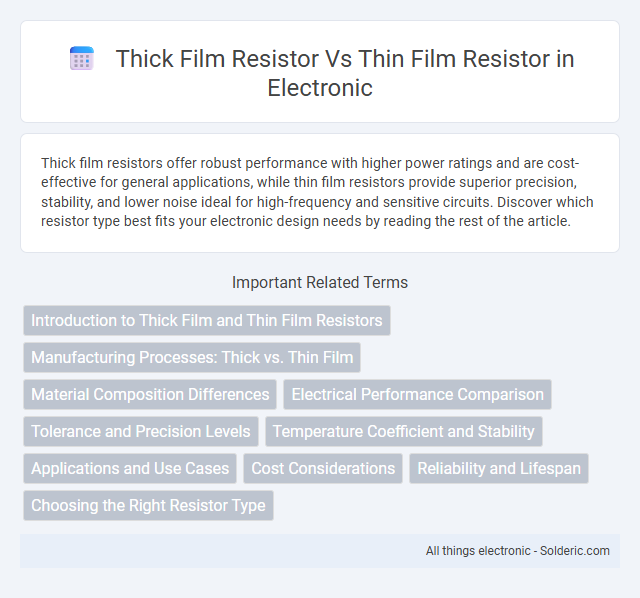Thick film resistors offer robust performance with higher power ratings and are cost-effective for general applications, while thin film resistors provide superior precision, stability, and lower noise ideal for high-frequency and sensitive circuits. Discover which resistor type best fits your electronic design needs by reading the rest of the article.
Comparison Table
| Feature | Thick Film Resistor | Thin Film Resistor |
|---|---|---|
| Manufacturing Process | Screen printing of resistor paste on ceramic substrate | Vacuum deposition of metal film on ceramic substrate |
| Resistance Range | 1 O to 10 MO | 1 O to 1 MO |
| Tolerance | +-1% to +-5% | +-0.1% to +-1% |
| Temperature Coefficient of Resistance (TCR) | +-100 to +-200 ppm/degC | +-5 to +-25 ppm/degC |
| Noise Level | Higher noise | Lower noise |
| Power Rating | Up to 2 W | Typically up to 0.5 W |
| Cost | Lower cost | Higher cost |
| Applications | General-purpose, high power, cost-sensitive | Precision circuits, low noise, high stability |
Introduction to Thick Film and Thin Film Resistors
Thick film resistors are made by depositing a resistive paste onto a ceramic substrate and firing it at high temperatures, resulting in cost-effective components with good power handling capabilities. Thin film resistors use a physical vapor deposition method to apply a very thin resistive layer, offering superior precision, stability, and low noise performance. Understanding these differences helps you select the right resistor type for your circuit's accuracy and durability requirements.
Manufacturing Processes: Thick vs. Thin Film
Thick film resistors are manufactured by screen printing a resistive paste made of conductive materials and glass onto a ceramic substrate, followed by firing at high temperatures to form a durable film. Thin film resistors use a sputtering process to deposit a thin layer of resistive metal alloy onto an insulating substrate, allowing precise control over film thickness and resistance values. The thick film process offers cost-effective production and higher power ratings, while thin film manufacturing provides superior accuracy and stability for precision applications.
Material Composition Differences
Thick film resistors are composed of a paste mixture containing glass and ceramic materials combined with conductive metals such as ruthenium or silver-palladium, which is screen-printed onto a ceramic substrate. Thin film resistors use a much thinner layer of metal alloy, typically nickel-chromium or tantalum nitride, deposited onto an insulating substrate through sputtering or evaporation techniques. The material composition in thick film resistors results in higher resistance and greater tolerance, while thin film resistors offer superior precision and stability due to their uniform and finely controlled metallic films.
Electrical Performance Comparison
Thick film resistors offer higher power dissipation and cost-effectiveness but generally exhibit greater noise and tolerance variations compared to thin film resistors. Thin film resistors provide superior electrical performance with higher precision, lower noise, and better stability, making them ideal for applications requiring tight tolerance and low temperature coefficients. Your choice depends on whether you prioritize cost and power or precision and reliability in electrical performance.
Tolerance and Precision Levels
Thick film resistors typically offer tolerance levels ranging from +-1% to +-5%, making them suitable for general-purpose applications requiring moderate precision. Thin film resistors provide superior precision with tolerance values as low as +-0.1% to +-0.01%, ensuring higher accuracy in sensitive electronic circuits. The enhanced stability and low temperature coefficient of thin film resistors make them ideal for precision measurement and calibration tasks.
Temperature Coefficient and Stability
Thick film resistors typically exhibit a higher temperature coefficient of resistance (TCR), often ranging from +-100 to +-300 ppm/degC, leading to less predictable performance under temperature variations. Thin film resistors offer superior stability with lower TCR values, usually between +-5 and +-50 ppm/degC, ensuring consistent resistance across a wide temperature range. This enhanced stability makes thin film resistors ideal for precision applications requiring minimal drift over time and temperature changes.
Applications and Use Cases
Thick film resistors are widely used in general-purpose electronics, automotive circuits, and consumer devices due to their robustness and cost-effectiveness. Thin film resistors find applications in precision measurement, medical instruments, and aerospace systems where high accuracy and stability are critical. You should choose thick film resistors for budget-sensitive projects and thin film resistors when your application demands superior performance and reliability.
Cost Considerations
Thick film resistors generally offer a lower cost compared to thin film resistors due to simpler manufacturing processes and less stringent material requirements. Thin film resistors provide higher precision and stability but at a premium price, making them suitable for high-performance applications where accuracy justifies the expense. Your choice depends on balancing cost against performance needs, with thick film resistors favored for budget-sensitive projects and thin film for precision-critical designs.
Reliability and Lifespan
Thick film resistors typically offer robust reliability under high-stress conditions with moderate lifespan due to their ability to withstand mechanical and thermal shocks. Thin film resistors provide superior precision and longer lifespan, benefiting applications requiring stable performance through extended use and minimal resistance drift. Choosing the right resistor for Your circuit depends on balancing the required endurance and precision levels for optimal reliability.
Choosing the Right Resistor Type
Thick film resistors offer cost-effective solutions with higher power ratings and greater tolerance to environmental stress, making them ideal for applications requiring durability and affordability. Thin film resistors provide superior precision, stability, and low noise performance, which is essential for high-frequency and sensitive electronic circuits. Your choice depends on balancing performance needs and budget constraints, ensuring optimal functionality in your specific electronic application.
Thick film resistor vs thin film resistor Infographic

 solderic.com
solderic.com